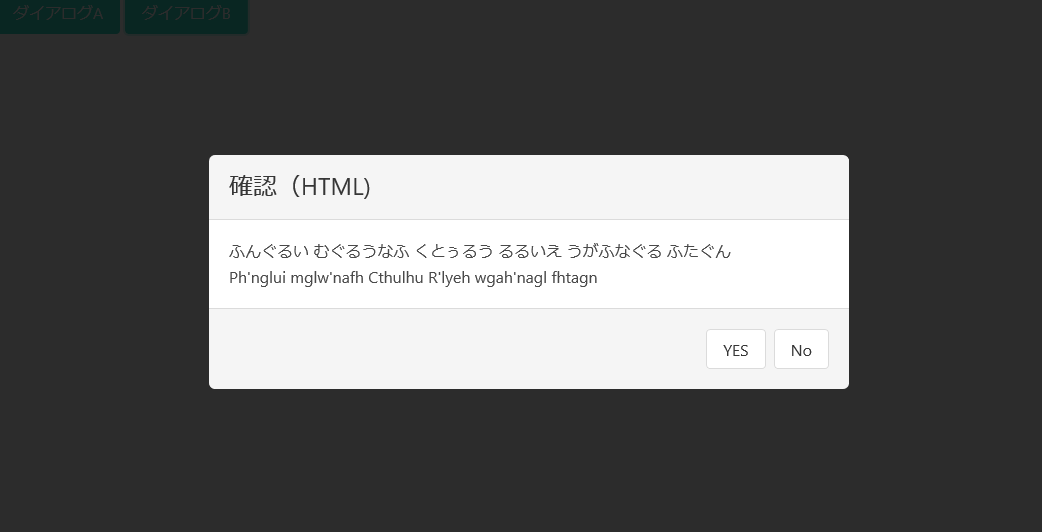Table of Content
目的
JavaScriptのフレームワークであるVue.jsとCSSのフレームワークである bulmaを使用してダイアログを表示してみる。

サンプル
Vue.jsにbulmadialog-componentコンポーネントを追加します。
その後、任意のタイミングで親側からコンポーネントのメソッドshowDialogを実行します。
この際、以下のプロパティを持つオブジェクトをパラメータに指定します。
- title : ダイアログのタイトル
- contents : ダイアログの内容。HTMLタグは無効
- html : ダイアログの内容。HTMLのタグは有効
- buttons : ボタン情報の配列
- caption : ボタンのタイトル
- callback : コールバック関数
コンポーネント側
IE11で動くようにしています。
bulma_dialog.js
/**
* bulma + vue.jsでダイアログを表示します。
* html: vue.jsの管理下に以下を追加します
* <bulmadialog-component ref="dialog"></bulmadialog-component>
* js:Vue.jsを作成するときにコンポーネントを追加する
* components: {
'bulmadialog-component': BulmaDialog,
},
* js:Vue.jsの親のメソッドにて以下を実行
* this.$refs.dialog.showDialog({
title:'わっふるる',
//contents:'わっふるぼでぃ0\nsadfasfd',
html : 'あたえたt<br>awrawtあたえたt<br>',
buttons : [
{
caption : 'はい',
callback : function () {
console.log('はい');
}
},
{
caption : 'いいえ',
callback : function () {
console.log('いいえ');
}
}
]
});
*/
// eslint-disable-next-line no-unused-vars
const BulmaDialog = {
/* eslint-disable max-len */
template: (function() {/*
<div v-bind:class="{ 'is-active': isShow }" class="modal">
<div class="modal-background"></div>
<div class="modal-card">
<header class="modal-card-head">
<p class="modal-card-title">{{data.title}}</p>
</header>
<div >
</div>
<section v-if="data.html" v-html="data.html" class="modal-card-body"></section>
<section v-else class="modal-card-body">{{data.contents}}</section>
<footer class="modal-card-foot" style="justify-content: flex-end;">
<button v-for="btnObj in data.buttons" type="button" class="button" @click="btnObj.callback(); isShow = false;">{{btnObj.caption}}</button>
</footer>
</div>
</div>
</div>
*/}).toString().match(/\/\*([^]*)\*\//)[1],
/* eslint-enable */
data: function() {
return {
isShow: false,
data: {
title: '',
body: '',
html: '',
buttons: [],
},
};
},
methods: {
showDialog: function(data) {
this.isShow = true;
this.data.title = data.title;
this.data.contents = data.contents;
this.data.html = data.html;
this.data.buttons = data.buttons;
},
},
};
使う側
<!doctype html>
<html>
<head>
<meta charset="utf-8">
<meta name="viewport" content="width=device-width, initial-scale=1">
<title>Hello Bulma!</title>
<link rel="stylesheet" href="https://cdn.jsdelivr.net/npm/bulma@0.8.0/css/bulma.min.css">
<script defer src="https://use.fontawesome.com/releases/v5.3.1/js/all.js"></script>
<script src="https://cdn.jsdelivr.net/npm/vue/dist/vue.js"></script>
<script src="/phptest/codeview/js/bulma_dialog.js"></script>
</head>
<body>
<div id="app">
<bulmadialog-component ref="dialog"></bulmadialog-component>
<button class="button is-primary" @click="test1">ダイアログA</button>
<button class="button is-primary" @click="test2">ダイアログB</button>
</div>
<script>
var app = new Vue({
el: '#app',
components: { //Scopedが使える
'bulmadialog-component': BulmaDialog,
},
data: function() {
return {
}
},
methods: {
test1 : function () {
this.$refs.dialog.showDialog({
title:'確認(TEXT)',
contents: "ふんぐるい むぐるうなふ くとぅるう るるいえ うがふなぐる ふたぐん<br>Ph'nglui mglw'nafh Cthulhu R'lyeh wgah'nagl fhtagn",
buttons : [
{
caption : 'はい',
callback : function () {
console.log('test1 はい');
}
},
{
caption : 'いいえ',
callback : function () {
console.log('test2 いいえ');
}
}
]
});
},
test2 : function () {
this.$refs.dialog.showDialog({
title:'確認(HTML)',
html: "ふんぐるい むぐるうなふ くとぅるう るるいえ うがふなぐる ふたぐん<br>Ph'nglui mglw'nafh Cthulhu R'lyeh wgah'nagl fhtagn",
buttons : [
{
caption : 'YES',
callback : function () {
console.log('Yes');
}
},
{
caption : 'No',
callback : function () {
console.log('No');
}
}
]
});
}
}
})
</script>
</body>
</html>参考
SafariでもエラーにならないJavascriptのヒアドキュメントの書き方
https://qiita.com/ampersand/items/c6c773ba7ae9115856d0
メモ
Bulma自体がIEのサポートを部分的にのみしかしていないので、テンプレートリテラルを使ってIEをあきらめた方が無難かも
Bulma uses autoprefixer to make (most) Flexbox features compatible with earlier browser versions. According to Can I use, Bulma is compatible with recent versions of:
- Chrome
- Edge
- Firefox
- Opera
- Safari
Internet Explorer (10+) is only partially supported.